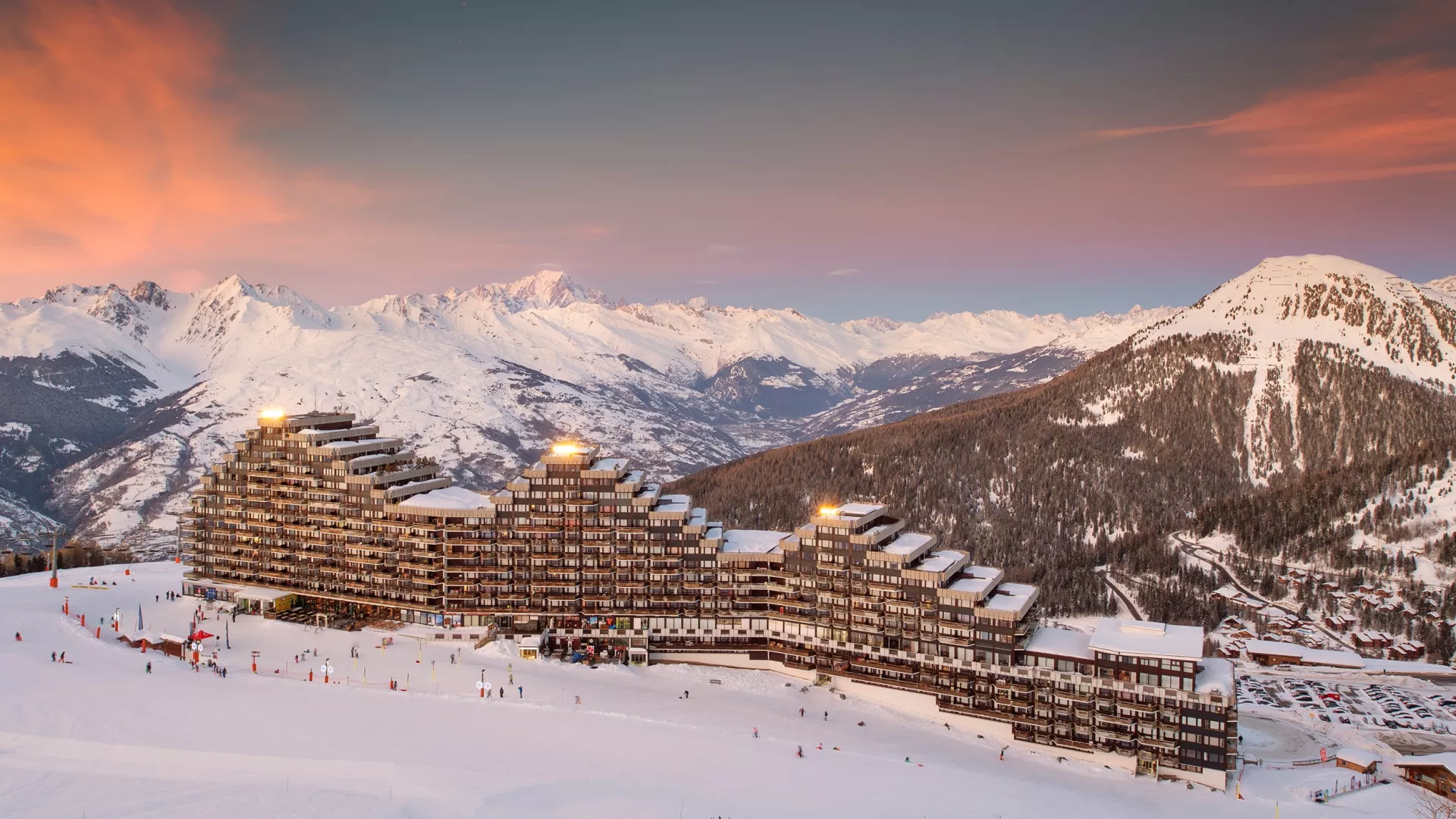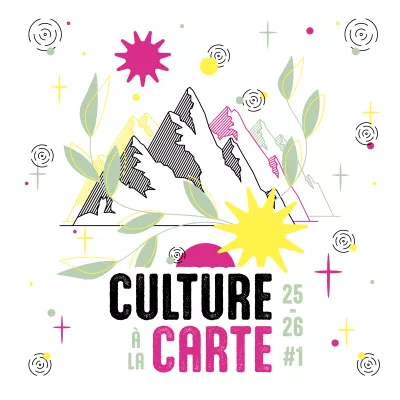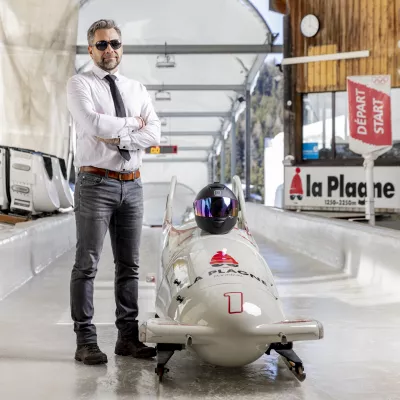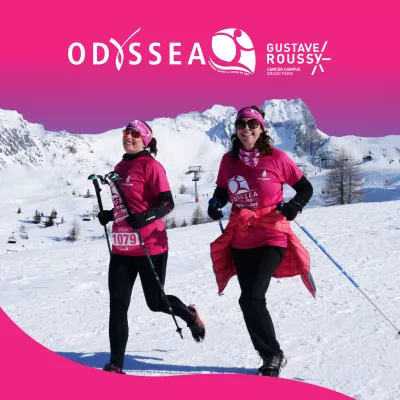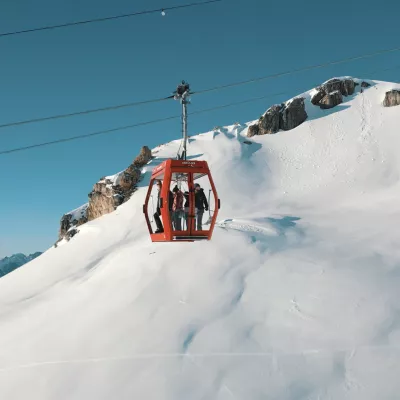Why this is important
Tourism represents 11% of France’s GHG emissions. Like all the other sectors, we have to do our share to reduce our emissions so as to achieve carbon neutrality by 2050, as set out in France’s National Low Carbon Strategy.
For a resort like La Plagne, greenhouse gas emissions are mainly linked to our tourism activity, with transport and buildings at the top of the list. What weighs the heaviest are the “indirect” emissions, the ones that come before and after our activities: the emissions linked to the transport of visitors travelling to La Plagne are part of this.
Our first steps
Our carbon assessment
In summer 2022, La Plagne began to calculate its carbon footprint with consultant UTOPIES. Find all the information here.
Decarbonising transport: how can this be done?
We know that the main source of greenhouse gas emissions in our destination is visitor transport. To solve this problem, we have several options:
👉 To invest massively in alternative solutions to carbon-based transport. To put in a lift from the valley
👉 To encourage users to change their daily behaviour: carpooling, shuttle buses, trains, etc.
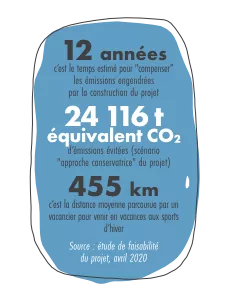
WHAT IF?
A valley lift project is under study to create a direct link between the SNCF train station in Aime-la-Plagne, where trains arrive directly from the major European capitals and French cities, and the bus station in Plagne Centre.
Main objectives:
-To offer visitors, as well as season workers and locals, a decarbonised link to the station (CO2 and fine-particle savings), as well as being faster than travel by road
-To facilitate the journey for holidaymakers arriving by train, (leaving from the train station platform) or car (large car parks in the valley, partly covered) close to the RN90, the backbone of the Tarentaise road network. This would avoid the need for special equipment to drive up to the resort in winter
-To integrate all the necessary services, both in the valley (parking...) and up the mountain (shuttle buses to the customers’ final destination), offering a sustainable, safe and environmentally friendly alternative to road access
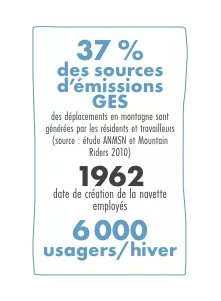
PROPOSING ALTERNATIVES and changing uses
A home-to-work shuttle for lift company employees
A forerunner as regards alternatives to individual transport, the La Plagne ski lift company has been offering its employees several regular shuttles for their daily trips between the valley and the resort for 60 years. In winter, several departures are organised from different sites in the valley and in the Versant du Soleil villages (on the other side of the valley). A real solution to reducing our mobility impact.
MODAL SHIFT: WHAT’S THAT?
Modal shift means changing one mode of transport for another that emits less greenhouse gas: for example, replacing a car with a bicycle, replacing a plane with a train... It is the best way to reduce emissions! It can sometimes seem complicated, as users must be encouraged and then convinced to gradually change their habits.
Renovating and transforming buildings
Plagne Bellecôte, the biggest renovation operation in the mountains
On Friday, 30 September 2022, the PRIAMS group bought the whole Résidence Bellecôte building in Plagne Bellecôte. This 15,000 m² building houses 405 apartments (approximately 2,000 beds), which were previously held by 3,400 timeshare owners. The property development group intends to renovate it completely by 2025, reducing the number of apartments to 250 and 1,500 beds. The building will be completely depolluted, stripped and redesigned for a better look, but also with a view to reducing its environmental footprint through the installation of a biomass heating system and solar panels that will cover over 50% of the building's needs.

The ‘Snow Cruise Ship’ in Plagne Aime 2000
In 2021, La Plagne gave a team of energy designers a complex task to carry out, performing an energy “quantum audit” for one of La Plagne’s most iconic buildings, the huge “Snow Cruise Ship” with its 860 apartments and 2,500 beds, situated 2 100 m above sea level.
Their mission: to find a different approach to renovating this building based on its use. How do people live in it? Year round? During the season? How is it heated? The apartments as well as all the shared areas (offices, shops, restaurants, etc.). How could the building’s energy impact be reduced whilst offering its occupants a greater level of comfort?
Key findings
🪟 Insulating and improving airtightness
⅔ of the building's surface consists of windows. These should be replaced with new frames made on site by a carpenter and quality glazing. The hitch is how many windows need replacing. The local carpenter estimates that it would take 400 years to do it all...
☀️ Producing renewable and local energy
By installing solar panels on the facades, for example (they cannot be put on the roofs because of fire regulations). The electricity produced could be used on site via a collective self-consumption model.
🤲 Rethinking the way we live at altitude
THE main lesson of this study. This building complex was designed at the time of its construction as a collective place favouring exchanges and communal life, but not in terms of energy. Each apartment’s consumption is independent. We need to move from everyone having their own meter to a collective entity managing the energy systems. Then we could rethink the way we live collectively at altitude: better heating, limiting our impact, and staying as long as possible up there, 4 months, 6 months, or more...
Reducing our direct footprint: synthetic fuel and eco-driving
The ski area’s direct greenhouse gas (GHG) emissions, mostly electric ski lifts, represent 9% of La Plagne’s carbon footprint (source: initial data from the GHG assessment for La Plagne, 2022). This is the perimeter that the professional chamber of French ski areas has announced for achieving carbon neutrality by 2037. But how do we go about it?

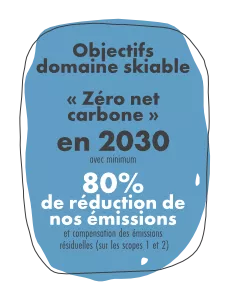
Grooming represents one of the main sources of GHG emissions of the ski area’s activities, with 23% of its direct carbon footprint (data from the UTOPIES carbon assessment, 2022) from using fossil fuels. Reducing consumption, particularly through eco-driving training and getting away from fossil fuels is therefore a priority subject.
Following a conclusive test carried out in Les Arcs and then in La Plagne, the lift company has decided to switch its entire fleet of snow groomers to synthetic HVO fuel from the 2022 winter season. This 100% renewable fuel, made from waste grease and used vegetable oil, without palm oil, that is compatible with all the partner manufacturers' equipment, is a substitute for diesel and reduces CO2 emissions by 83%. The use of HVO will be effective from this winter 2022/2023 on all of the resort’s snow groomers.
🪧At the project stage:
-
Test to convert a combustion 4x4 to electric in 2023
1st vehicle available: spring 2023 -
Prototype of an electric groomer to be tested in 2023, then a gradual renewal of the fleet.
Water, a valuable resource

Water resources are a structuring element in mountain territories. It interacts on many levels, such as tourism, drinking water, natural hazards and industry.
Veolia & its subsidiary ECHM are responsible for protecting the territory’s water resources and the implementation of management tools such as supervision software linked to flow meters, has made it possible to save water.
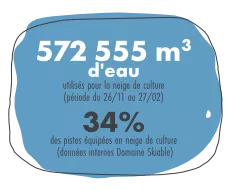
💧 Water also represents a key parameter for the ski area’s professionals who use it to make snow and guarantee the winter’s economic activity. The Environmental Observatory of the SAP (Société d'Aménagement de La Plagne, in charge of the ski area) therefore scrutinises water all year round because it is a specificity of the mountain environment: water is present in gaseous, liquid and solid form.
❄️The ski area has a high hydrographic density, characteristic of mountain areas. There are 3 confluences of the watercourses in the ski area:
-The Isère to the north of the resort;
-The Ponturin to the northeast of the resort;
-The Doron de Champagny-en-Vanoise to the south of the resort, which then flows into the Doron de Bozel.
The river Ponturin and the Doron de Bozel then flow into the river Isère. Most of the watercourses in the resort are temporary and feed the main, permanent rivers further downstream.

In addition to the mountain streams, the perimeter of the Environmental Observatory that has been set up in La Plagne includes six altitude reservoirs and several natural lakes.
Hydroski, a research project on a ski area’s impact on water resources
The Compagnie des Alpes, the parent company of the La Plagne ski area manager, is supporting a research project with prestigious institutes (INRAE, CNRS, CNRM-Météo France) aimed at modelling the hydrological disturbance linked to the presence of a ski area at different scales of catchment areas, and integrating the various climate change scenarios. The project has been finalised and the conclusions are currently being reviewed by a scientific committee. The La Plagne site was used as a pilot site for this research project, which makes it possible to measure the quantitative impacts according to the months of the year, and at micro or valley scales at the point where the water flows into the river Isère.
Energy efficiency
In this year’s particularly difficult energy context, but also with a long term view to reducing our impact, La Plagne is committing to a certain number of measures to reduce the consumption of its infrastructures.
💡 In our communes
The commune of Aime-la-Plagne opted not to put up Christmas lights. This was above all a symbolic and exemplary show of participation in the national effort. Only one tree was lit during the Christmas holidays and the emphasis was on non-luminous Christmas decorations. Through this action, as well as by switching off public lighting for most of the night, even in the resorts, the town is contributing to reducing electricity consumption.
This represents the turning off of 1150 lights for 4hrs
🏔️ In the ski area
Illustration 160 000 kwh saved (over 1 year )
Short term objective (winter 2022/2023): 8 to 10% reduction in electricity consumption across the ski area
-
Production of artificial snow limited to what is needed and optimised
-
Raising employee awareness of the best energy saving practices
-
Adapting the speed of ski lifts to numbers of people using them
❄️ On the Olympic bobsleigh track
Lighting
The number of lights will be reduced as much as possible and LED lights used everywhere on the track. The use of lights that cannot be changed to LED will be kept to a strict minimum. Generally speaking, the track will only be lit while it is being used for descents and maintained.
Refrigeration
Refrigeration is the second lever for energy savings. The idea is to keep the compressors running at a minimum by playing with the inertia and weather conditions that affect cold production.
To be as efficient as possible, La Plagne is adding one person to the technical team who will be seconded to make the necessary adjustments.
💧 Indoor and outdoor swimming pools
-The water temperature will be lowered by 0.5 to 1°C
-Optimisation of opening periods according to customer numbers
-Implementation of a geothermal system to heat the pool in Champagny-en-Vanoise
🔥 The Plagne Centre biomass heating plant, a first in the mountains
Commissioned in December 2009, the biomass heating plant in Plagne Centre remains a unique achievement in the mountains, 1900 m above sea level. Initiated by an association of Plagne Centre property owners and Veolia Eau, this operation is a solution to the major issue of heating in a winter sports resort built in the early 1960s. Apartment insulation work was carried out at the same time as the construction to reduce unnecessary energy expenditure. The biomass heating plant supplies 90% of Plagne Centre, i.e. some 50 buildings and 90 shops. In the form of shredded wood chips, the bark comes from sawmills and fibres that cannot be recycled into compost. The long-term goal is to obtain wood chips from local operators in order to help them finalise projects related to the wood industry.
Better integration of facilities
The Environmental Observatory’s Landscapes section allows us to assess and limit the impact of our developments on the landscape over time, whether they are protected landscapes (classified or listed sites, the Vanoise National Park, nature reserves, heritage buildings) or frequented sites (Chiaupe glacier, Grande Rochette scenic viewpoint, GR trail, etc.), as well as to measure the effectiveness of measures to integrate and/or rehabilitate the landscape. Through regular photographic monitoring, we measure the evolution of 'landscape views' on three scales: the territory as a whole, the more local views and views of specific points (such as the bottom of a ski lift for example). An analysis of these three scales allows us to envisage solutions at different levels: revegetation to integrate earthworks better, rehabilitation of buildings, remodelling that is more integrated with the natural terrain, etc.
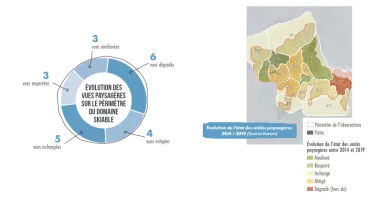
Les Glaciers gondola project, a necessary adaptation
Climate change is already producing visible impacts on activity in La Plagne’s ski area, with two major effects: the melting of the glacier and the permafrost which is weakening the ground, accelerating rockslides like the one that we experienced this autumn on the Bellecôte glacier sector, as well as the stability of the infrastructures situated in this glacial zone.

In order to ensure a quality ski area at high altitude over the coming years, the ski area manager has already been working for several years on a project to reorganise the ski area on the glacier. A new area, going from the valley under the Rochu to the north ridge of Bellecôte will be developed with a gondola, while the equipment on the part of the glacier that is currently used will be completely removed. This type of major project for the future of the ski area is not without an impact. The manager therefore carries out a regulatory impact study upstream of the project and has this examined by the MRAe (an independent authority that analyses impact studies and gives its opinion on whether they take the environment into account) in order to analyse in detail all of the measures that will make it possible to avoid, or otherwise to reduce or compensate, the impacts on the local biodiversity, landscape integration, and the protection of wetlands in particular.

